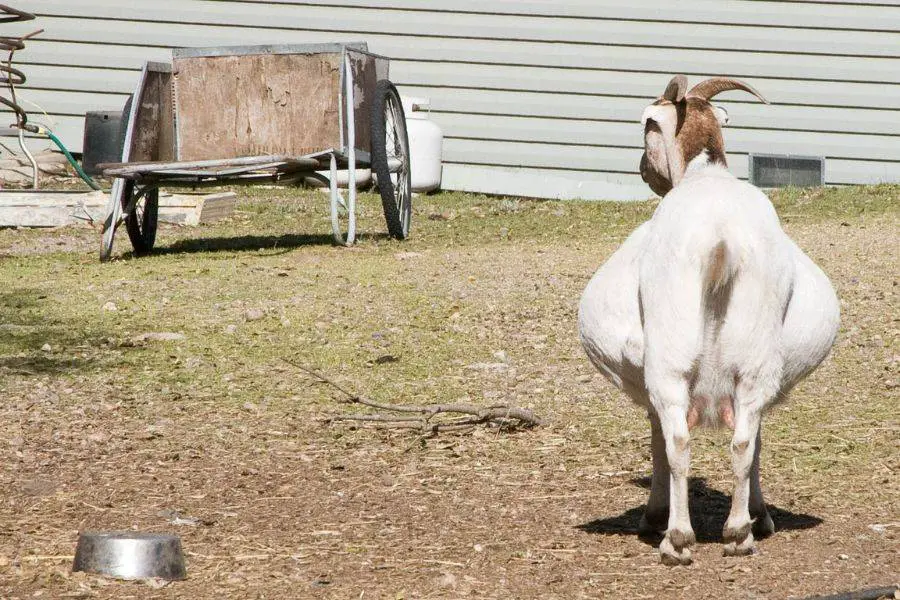Table of Contents
Pregnancy brings joy and, at the same time, is filled with a lot of anxiety. Just like women and pregnancy, there are a lot of myths out there about figuring out if a goat is pregnant.
Some rely on facts, but the laboratory pregnancy test is the most accurate.

The Pooch Test
The pooch test is one of the home pregnancy test techniques that is not a darling to most goat breeders.
After rearing goats for a while, if you are keen on pregnant goats, you will realize that towards the end of the pregnancy, the vulva of some goats become puffy.
The pooch test entails examining the way the skin around the butt of a pregnant goat behaves and also touching or palpating the pregnant goat.
There are various types of abdominal palpations to determine whether a goat is pregnant or not. In this section, you will learn how to perform each kind of palpation.
Rectal Abdominal Palpation
Rectal abdominal palpation is done on pregnant goats and ewes. For accuracy of this process, the doe should not eat the fortnight to the examination.
Performing Rectal Abdominal Palpation:
- Take a plastic rod of 1.5 by 50 cm, lubricate it, and gently insert not more than 35 cm of it into the rectum.
- Place the other hand on the posterior abdomen as the other gently moves the rod up and down, side by side, until you encounter an obstruction.
Rectal abdominal palpation is accurate on the 60th day of pregnancy. It is a simple, accurate, and quick means of determining if your goat is pregnant at home.
Abdominal Palpation
Abdominal palpation is accurate when the goat is in the late stages of pregnancy and gives a correct result.
To perform this procedure, place your hand on any of the sides of the abdomen of the pregnant goat. Then squeeze the belly as you lift it up and down.
During the last month of pregnancy, the fetus is sometime balloted low at the flank. For accuracy of this procedure, the goat should not eat 12 hours before abdominal palpation.
Cervical Palpation
Cervical palpation gives accuracy on the 50th day after conception. The procedure involves having a feel of the reproductive part of the pregnant goat.
When the cervix is soft, or you are not able to reach it is an indication that the goat is pregnant.
If the cervix is conical and projected towards the vagina is an indication that the does are not pregnant.
Pros of Pregnant Goat Pooch Test
A goat pooch test is a home-based examination that you can perform to determine if your goat is pregnant or not.
Performing this procedure is not complex, and every goat owner can comfortably carry it out.
A pregnant goat pooch test does not require special equipment; you will need your hands and maybe locally available tools such as a plastic rod.
The accuracy of the pregnant goat pooch test is relatively high since it entails observation and feeling. The one carrying out this procedure will see and feel with hands if the goat is pregnant.
The pregnant goat pooch test will be the first test every goat owner will perform to determine whether their goat is pregnant before using other methods of testing pregnancy, such as ultrasound.
You will first observe the physical changes taking place on your goat.
Cons of Pregnant Goat Pooch Test
The pregnant goat pooch test is relatively less accurate than other methods. The physical examination of a goat may fail to give a precise result.
Telling whether a goat is pregnant or fat is difficult through this process. Sometimes a fat goat may be confused of being pregnant.
When observing the vulva of a goat, you might confuse a goat in the heat with being pregnant. Both pregnant and goats on heat develop a puffy vulva.
The procedure may be complex and fail to give accurate results when done with the first timers.
First-timers will find it complicated to touch and feel the abdomen of a pregnant goat. A baby does not just lie on any part of the abdomen but in a specific position. Failure to touch this part, you might not feel the presence of the baby.
Signs that a Goat is in Labor
After using the pooch test and it has revealed that your goat is pregnant, the next major step is delivery.
It is difficult to determine when your goat is in labor because every goat has various distinctive signs. Here are the common signs that your goat is in labor.
The Goat Bags Up
Bagging up indicates that your goat is ready to provide milk for her baby. If it is your goat’s first delivery, the udder will take time to mature.
If the goat had given birth previously, she would start bagging a month before her due date.
When a goat is almost delivering, you will note that the udder will look tight and shiny as the tits will point sideways.
The Shape of the Goat Will Change

As the baby moves into position, you note that the goat’s belly will start to sag. When it is less than 24 hours to delivery, you will realize that the baby will no longer be moving when you press her flanks.
As the baby drops in position, the sides of your goat will appear hollow, and the hip bones will stick out.
Discharges
The appearance of thick white or yellowish mucus from the birth canal is one of the last stages that your goat will give birth anytime.
Some goats might discharge cloudy mucus as early as a month before the due date. But the thick mucus discharge, looking like a long rope, is evidence that your goat is soon giving birth.
The Bursting of the Water Bag
As the goat starts to push, the water bag will appear from the vaginal opening. This bag may come out intact or might burst.
Another bag with a dark fluid will appear, which is amniotic fluid. These fluids protect the kid and offer a conducive environment up to delivery.
Next, you will see the front legs of the kid accompanied by a tiny nose. At this moment, your goat is already delivering. The anxiety stops at this point because of the normal delivery by your goat.
Takeaway
Goats are interesting and valuable animals to keep on your farm. To keep your goat healthy and give you value for your money, you must take care of it.
The conception period up to delivery is the most critical moment for every goat.
Sometimes it might not be easy to tell when your goat is pregnant, but the pregnant goat pooch test is a home test that can help you determine that.
The pooch test fails only to be accurate because the signs it relies on are similar to the symptoms of a goat on heat.
After performing the pregnancy pooch test for your goat, it is necessary to accompany it with other tests to ensure the goat is pregnant. Such tests include ultra-sound, blood, and milk test.
After proving that your goat is pregnant, it is necessary to know the signs your goat will have when in labor pain.
This article has equipped you with essential information about a goat’s pregnancy. And precisely about the pregnant goat pooch test.









